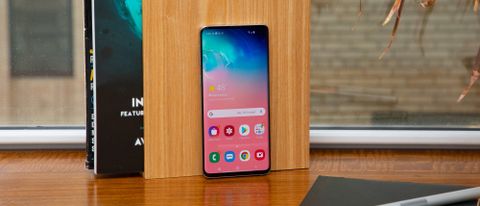Why you can trust TechRadar
Samsung Galaxy S10: camera
- Triple-lens camera
- 12MP wide, 16MP ultrawide, and 12MP telephoto
Samsung wants you to take photos at any angle, so the Galaxy S10 has a triple-lens camera on back with a 12MP regular lens, 12MP optically zoomed telephoto lens, and a brand new 16MP ultra-wide lens.
We found that the Samsung Galaxy S10 and S10 Plus have the same cameras – on the back at least. Here's our mix of shots during of month and a half of testing:

The Galaxy S10 camera takes excellent photos, even in mixed and low light conditions. It's not too dark on our subject, US Mobile Editor David Lumb, and the bright moving flames are captured with detail without being overexposed.

Here's the same shot in Live Focus (Samsung's portrait mode). It properly blurs the background, and you can change the background blur intensity even after the shot is taken. Samsung also includes blur filters: artistic, spin, zoom and color point (which in this case made the background black and white). They're actually really cool looking.

Shot suggestions helped us frame up the shot. This camera reticle can be helpful and you don't have to snap the photo. The shutter just activates when you hover over the reticle 'Best Shot' dot. But it's not always accurate. Sometimes it stuck the circle off-center in a group shot for no apparent reason. Overall, it's a nice touch with some room for improvement.

In our ongoing Galaxy S10 camera review, we've noticed subjects up close with enough light contain excellent detail. Rejoice food photo takers. The scene optimizer AI works well for food.

The 12MP camera gives us a lot of detail, and while vibrancy and saturation are cranked up a bit compared to an iPhone, Samsung's camera no longer makes food look oversaturated and alien looking. There was a time when Samsung's cameras would make hotdogs, for example, look fire engine red by amping up contrast.

Testing the blur effect of the main camera (without switching to portrait mode) proved to give us the depth effect we desired. Strong detail in the foreground, with rich bokeh in the background.

We tapped the background to get that in focus, and the bokeh gave our foreground some nice blur. The detail in the background is crisp – like the fried chicken.

The Galaxy S10 camera sometimes looks better than real life. Its blues and orangey-reds here really pop, while the white doesn't appear to be too warm to along with it (before you often couldn't have one without the other). We still feel the Google Pixel 3 Night Sight mode does a better job, but Samsung is very close. More comparisons to come.


Here's a well-lit location of two subjects. The photo avoids being too warm, striking fairly good color and white balance.

Here's the same shot from the new ultra-wide camera. The hard part about such a wide camera is that there's often needless excess in there. Cropping or using the regular lens is just fine. Not every shot deserves this camera lens, but it creates a neat effect in the situations.

Here's another ultra-wide photo we took using the S10 camera. This is a more appropriate picture demonstrating some of the elements you'd miss with the tighter regular lens.

The S10 is good at active tracking fast-moving subjects. Case in point, it was able to capture these bright flames as they moved in the San Francisco wind. They're crisp, not blurry, and not overexposed despite the camera also needing to capture the dark stones.

We still find the Samsung's camera to amp up vibrancy and saturation, also applying an Instagram filter ahead of time. This works well for us, but comes down to taste. The iPhone XS we use often has true-to-life colors, but next to the S10 or Google Pixel 3, they look rather drab.
We've taken a hard look at the Galaxy S10 camera and how its photos compare to those of the class-leading Pixel 3, then determined how good the ultra-wide photos look. Our conclusion? Samsung's camera comes close, but Google's post-processing software still engineers a better photo.
The main S10 camera exhibit punchy, Instagram-ready colors and looks better than the muted photos out of an iPhone in most cases. It's one of the best camera phones out now. However, its HDR prowess can, at times, blow out bright backgrounds during daytime shots. And lowlight, while good enough, does have serious noise reduction to reduce grain. That only leads to a lot of skin smoothing, as if you put on beauty mode when you didn't.
The good news is that we found the Galaxy S10 camera to be more versatile and fun in some ways. Take for instance, the ultra-wide camera's 123-degree field of view. It serves the purpose of not having to back up to get everything in a shot, something you won't get on the Pixel 3.

The ultra-wide camera isn't always sharp (there's no OIS on this lens like there is on the other rear lenses) and you'll have to watch out for unnatural fisheye look at the edges. Anyone unfortunate to be on the edges of a group photo can exhibit 'fat face.' But when it works, you're really glad you have this option. Just pack everyone into the center of group shots, and leave the scenery on the edges. Ultra-wide photos do work really well for landscape shots, when people aren't the main subject.
What we got the most use out of is the new Live Focus filter option. Specifically, the Color Point filter allows you to go beyond simple bokeh by making the background black-and-white, while keeping your subject in the foreground in color. The camera doesn't always get the snap right, but keep pressing the shutter button and it'll adjust and figure out how to separate the monochrome background from the color foreground eventually.

On the front, we have a single 10MP camera. If you upgrade to the S10 Plus, you’ll also get an 8MP camera meant for enhancing depth in portrait photos. In our tests, the difference are minor. Samsung's S10 single front-facing camera relied heavily on software to blur the edges around our hair. The S10 Plus dual-selfie cam did better.
Scene optimizer gains 10 new categories, with Samsung’s camera AI now able to tell the difference between a cat and dog to fine tune things like white balance. Shot Suggestions is a new feature that uses the neural processor engine to nudge you to properly level your shots or frame subjects better.

On the video side, the software has been upgraded to record offer Digital Video Stabilization. Samsung says that this is meant to make all of your Ultra HD video as smooth as an action cam. Shots fired, GoPro Hero7 Black.
There's also HDR10+ video recording, which is significant because last year's S9 didn't offer HDR recording at all (when other phones from Sony had this feature). It pulls in a wider amount of contrast, though the HEVC (smaller files) codec turns off when you enable Samsung's lab-labeled HDR10+ feature in the settings. It worked well for us, but expect higher file sizes and maybe a few hiccups, as it appears to be experimental.
- John McCannGlobal Managing Editor

